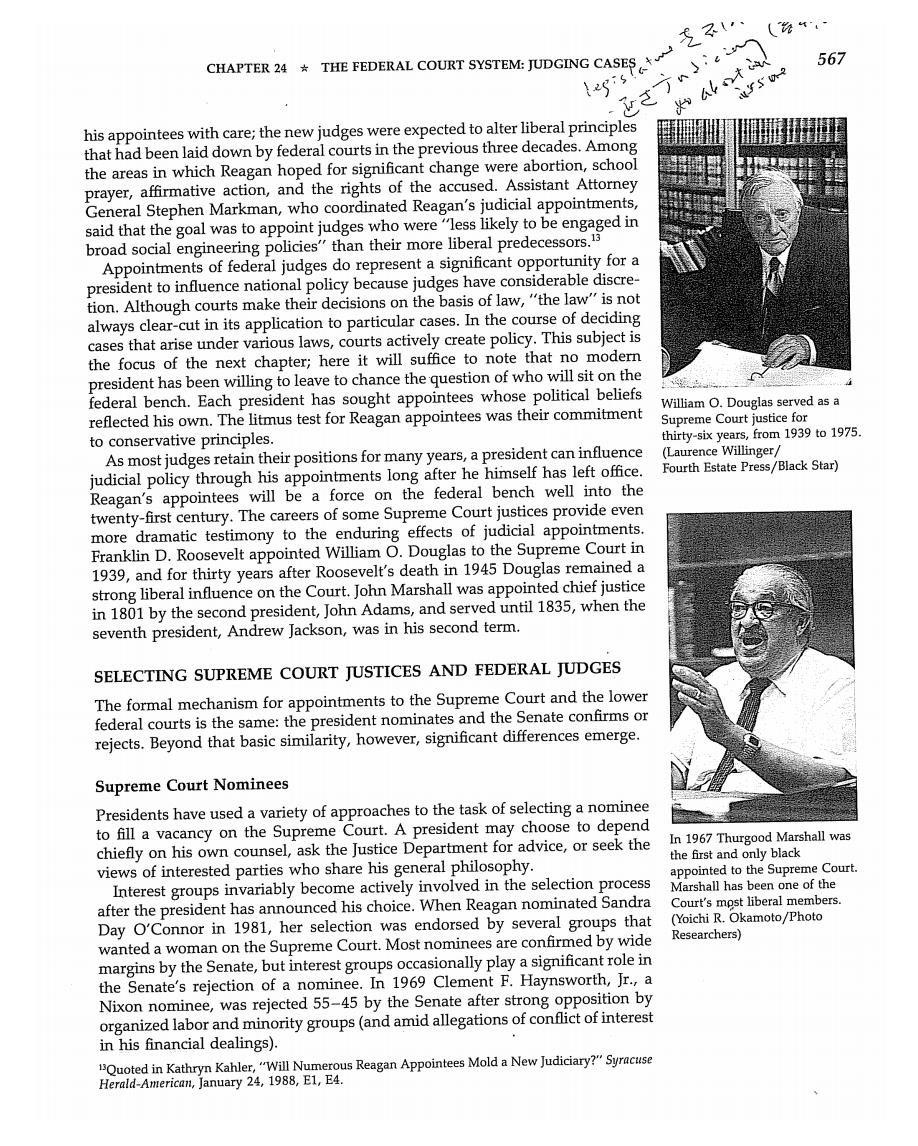正在加载图片...

(%4,- CHAPTER24★THE FEDERAL COURT SYSTEM:JUDGING CASES+乏不({' 567 asswe his appointees with care;the new judges were expected to alter liberal principles that had been laid down by federal courts in the previous three decades.Among the areas in which Reagan hoped for significant change were abortion,school prayer,affirmative action,and the rights of the accused.Assistant Attorney General Stephen Markman,who coordinated Reagan's judicial appointments, said that the goal was to appoint judges who were"less likely to be engaged in broad social engineering policies"than their more liberal predecessors.13 Appointments of federal judges do represent a significant opportunity for a president to influence national policy because judges have considerable discre- tion.Although courts make their decisions on the basis of law,"the law"is not always clear-cut in its application to particular cases.In the course of deciding cases that arise under various laws,courts actively create policy.This subject is the focus of the next chapter;here it will suffice to note that no modern president has been willing to leave to chance the question of who will sit on the federal bench.Each president has sought appointees whose political beliefs William O.Douglas served as a reflected his own.The litmus test for Reagan appointees was their commitment Supreme Court justice for to conservative principles. thirty-six years,from 1939 to 1975. As most judges retain their positions for many years,a president can influence (Laurence Willinger/ judicial policy through his appointments long after he himself has left office. Fourth Estate Press/Black Star) Reagan's appointees will be a force on the federal bench well into the twenty-first century.The careers of some Supreme Court justices provide even more dramatic testimony to the enduring effects of judicial appointments Franklin D.Roosevelt appointed William O.Douglas to the Supreme Court in 1939,and for thirty years after Roosevelt's death in 1945 Douglas remained a strong liberal influence on the Court.John Marshall was appointed chief justice in 1801 by the second president,John Adams,and served until 1835,when the seventh president,Andrew Jackson,was in his second term. SELECTING SUPREME COURT JUSTICES AND FEDERAL JUDGES The formal mechanism for appointments to the Supreme Court and the lower federal courts is the same:the president nominates and the Senate confirms or rejects.Beyond that basic similarity,however,significant differences emerge. Supreme Court Nominees Presidents have used a variety of approaches to the task of selecting a nominee to fill a vacancy on the Supreme Court.A president may choose to depend chiefly on his own counsel,ask the Justice Department for advice,or seek the In 1967 Thurgood Marshall was the first and only black views of interested parties who share his general philosophy. appointed to the Supreme Court. Interest groups invariably become actively involved in the selection process Marshall has been one of the after the president has announced his choice.When Reagan nominated Sandra Court's mpst liberal members. Day O'Connor in 1981,her selection was endorsed by several groups that (Yoichi R.Okamoto/Photo wanted a woman on the Supreme Court.Most nominees are confirmed by wide Researchers) margins by the Senate,but interest groups occasionally play a significant role in the Senate's rejection of a nominee.In 1969 Clement F.Haynsworth,Jr.,a Nixon nominee,was rejected 55-45 by the Senate after strong opposition by organized labor and minority groups(and amid allegations of conflict of interest in his financial dealings). Quoted in Kathryn Kahler,"Will Numerous Reagan Appointees Mold a New Judiciary?"Syracuse Herald-American,January 24,1988,E1,E4